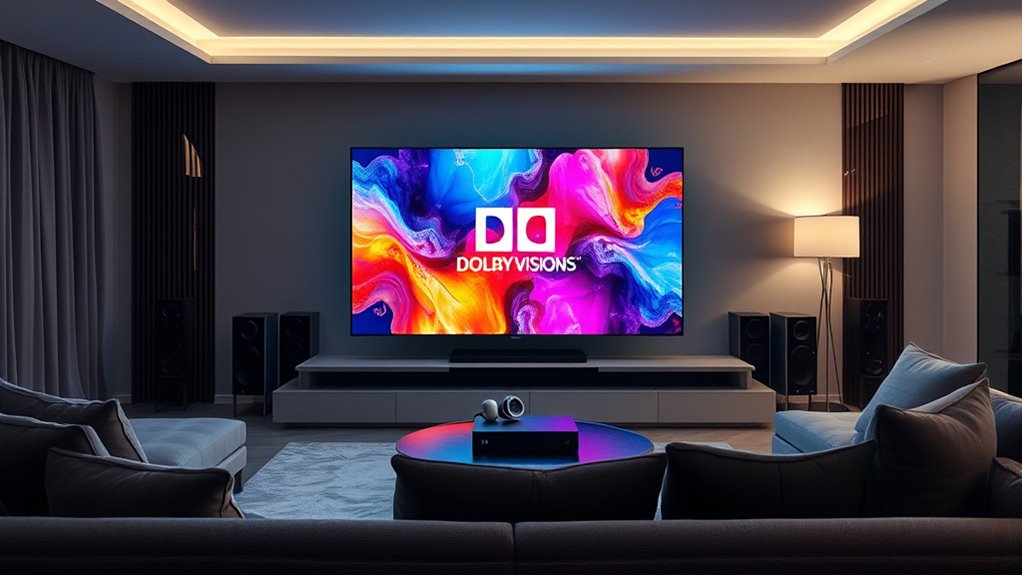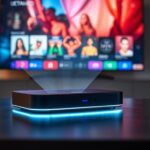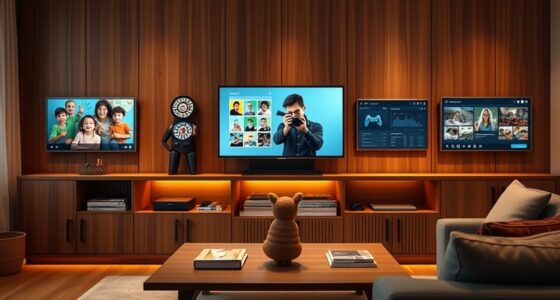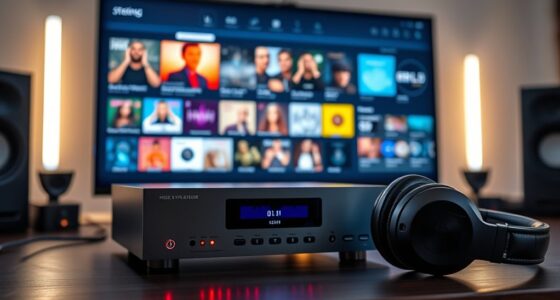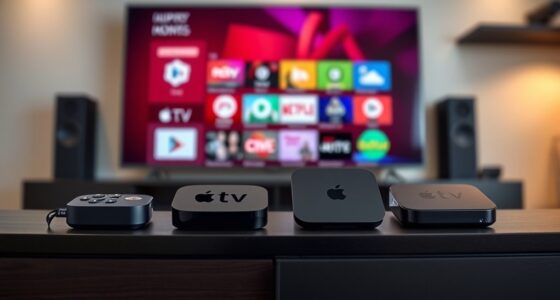Streaming services like Netflix, Disney+, and Apple TV+ support Dolby Atmos and Vision, offering immersive sound and stunning visuals. These platforms guarantee you experience high-quality audio combined with vibrant picture quality on compatible devices. Keep in mind, not all titles or devices may support these features, so it’s crucial to check content and hardware compatibility first. If you want to learn about the best ways to maximize your streaming experience, stay tuned for more insights.
Key Takeaways
- Major platforms like Netflix, Disney+, and Apple TV+ support Dolby Atmos and Vision for select titles.
- Compatibility depends on having supported devices such as compatible smart TVs, soundbars, or AV receivers.
- Not all content on these platforms includes Dolby Atmos and Vision; check specific titles beforehand.
- Upgrading hardware may be necessary to fully experience immersive audio and visuals.
- Verifying device and content compatibility ensures access to Dolby Atmos and Vision features.
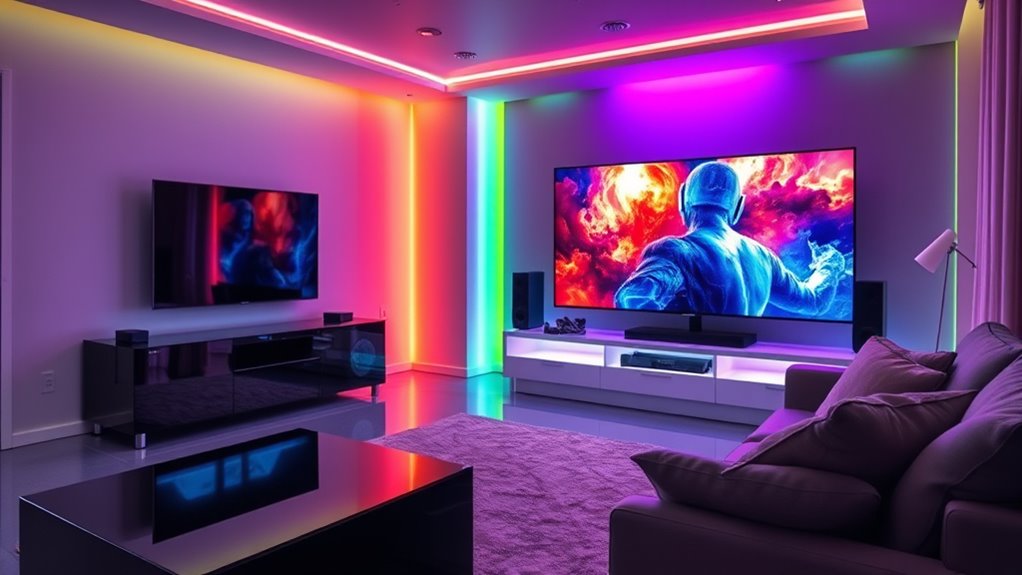
When it comes to audio quality, Dolby Atmos creates a three-dimensional soundscape that surrounds you, making you feel as if you’re right in the middle of the action. Not all streaming services support this level of audio immersion, so it’s key to choose the ones that do. Platforms like Netflix, Disney+, and Apple TV+ offer Dolby Atmos support for select titles, but they require compatible devices such as specific smart TVs, soundbars, or AV receivers. Check whether your current setup can handle Dolby Atmos to avoid disappointment. If your equipment isn’t compatible, you might need to upgrade some components, but the payoff is well worth it—experiencing movies and shows with crystal-clear, multidimensional sound can truly transform your viewing experience. Additionally, understanding content support is crucial to ensure the titles you want are available with Dolby Atmos and Vision. Device compatibility is another vital factor. Not every device supports Dolby Atmos and Vision, and each streaming service has its own set of hardware requirements. For example, to enjoy Dolby Vision on Netflix, you’ll need a compatible 4K TV and possibly a streaming device like Apple TV 4K, Chromecast Ultra, or a gaming console that supports the feature. Similarly, Disney+ supports Dolby Atmos on certain devices, but not all smart TVs or streaming sticks are compatible. Before subscribing, double-check the platform’s device requirements and ensure your current equipment can deliver the promised quality. If it can’t, upgrading your hardware might be necessary, but it guarantees you access to the full, high-fidelity experience.
Frequently Asked Questions
Do All Devices Support Dolby Atmos and Vision Simultaneously?
No, not all devices support Dolby Atmos and Vision simultaneously. Device compatibility varies, and you need compatible hardware like specific TVs, soundbars, or AV receivers. Even if your device supports these features, the content availability might be limited, so you’ll want to check whether the stream or app offers Dolby Atmos and Vision. Ensuring your device and content support these features guarantees the best experience.
Are There Additional Costs for Dolby Atmos and Vision Content?
You might face additional costs for Dolby Atmos and Vision content, depending on the streaming service’s pricing policies. Some platforms include these features in their standard subscriptions, while others charge extra. Device compatibility also plays a role; only certain devices support Atmos and Vision. Always check the platform’s details and your device’s capabilities to avoid surprises and guarantee you get the immersive experience you want without unexpected charges.
How Do I Verify if My Device Is Compatible?
Did you know over 60% of devices are compatible with Dolby Atmos and Vision? To verify your device, check its specifications or user manual for Dolby Atmos and Vision support. You can also visit your streaming service’s website for device compatibility lists. Confirm your device meets streaming requirements, such as having the latest software updates and supported HDMI or HDMI ARC ports, to enjoy immersive audio and visuals seamlessly.
Is Internet Speed a Factor for Streaming Dolby Atmos and Vision?
Yes, internet speed impacts streaming Dolby Atmos and Vision. You need sufficient bandwidth to guarantee high streaming quality; typically, a minimum of 25 Mbps is recommended for 4K HDR content with Dolby Atmos and Vision. If your internet is slower, you might experience buffering, lower resolution, or audio dropouts. To enjoy the full experience, make sure your connection meets or exceeds these bandwidth requirements for smooth, high-quality streaming.
Can I Upgrade Existing Subscriptions to Include Dolby Atmos and Vision?
Yes, you can often upgrade your existing subscriptions to include Dolby Atmos and Vision. Check your streaming service’s settings or plan options, as many platforms offer add-ons or premium tiers that enhance audio quality and expand content availability with immersive sound and visuals. Upgrading improves your viewing experience, but make sure your device and internet speed support the higher quality streams for seamless playback.
Conclusion
As you explore the world of streaming, Dolby Atmos and Vision turn your screen into a vibrant, immersive canvas, where sound and sight dance around you like a symphony in full bloom. These services paint your movies with vivid colors and surround you with rich, layered audio, transforming your space into a cinematic universe. With just a click, you open a portal to a sensory adventure, where every scene feels alive and every note resonates deep within your soul.
